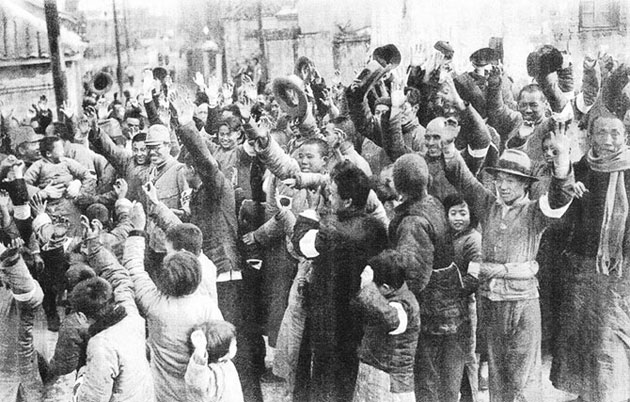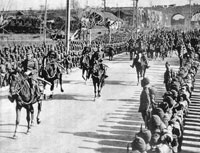How It Can Be Claimed That the “Nanking Massacre” Never Happened?
"Some Views of Western Experts Who Thought Japan's War Was Justified" (Part 11)

Scene of Nanking refugees cheering as the Japanese Army hand out sweets and tabacco.
The white armband the Chinese has on the left arm shows that he does not belong to the Nationalist Party Army (guerrilla fighter).

The Imperial Japanese Army entering Nanking
Led by General Iwane Matsui.
In 1937, to bring the fight with the Chinese Nationalist Party to an end, Japan captured the capital, Nanking. At that time, it is alleged that the Japanese Army massacred 300 thousand people during a period of two months in what’s called the “Nanking Massacre”. But the evidences presented contradict each other and shows itself to be a clear forgery.
In Nanking at the time, the Nationalist Party troop’s Chiang Kai-Shek had retreated, and the remaining soldiers fought back as guerrilla fighters disguising themselves as civilians. As guerrilla warfare is illegal under international law, it is not a war crime to kill on sight. This was then called a “massacre of the citizens”.
Furthermore, the foreign journalist who reported on the massacre was someone who had deep relations with the Nationalist Party. For instance, Timperley of Australia, published “What War Means” in London in 1938, and reported this incident for the first time. As a third-party reporter, the work was considered as objective evidence for a long time, but it was later revealed that he was a consultant to the Nationalist Party. In his work, it is written that “300 thousand people were massacred,” but in 1938, an international committee reported that there were 49 cases of murder by the Japanese military during a period of 2 months.
Moreover, the Nationalist Party held press conferences in Hankou numerous times during the war, but they never touched upon the Nanking massacre. Not even Chiang Kai-shek claimed that a massacre had occured. If there indeed was a massacre, they would have announced it right away.
Afterwards, there were no conspicuous reports about a massacre taking place until the issue was revisited at the Tokyo Trials that began in 1946. General Iwane Matsui, who was in command of the Nanking invasion, received the death penalty.
However, there were contradictions in the trial as well. Professor Bates who was part of the international committee in court stated that, “12 thousand people were massacred.” However, he also states later to a journalist of Asahi Newspaper, “It was a good thing that the well-ordered Japanese troops entered Nanking and brought peace,” (Masaaki Tanaka, “A Review of the ‘Nanking Incident'”) a complete opposite of what he said elsewhere.
Furthermore, the population of Nanking at the time was some 200 thousand people, making it impossible that 300 thousand people were killed.
Lies Being Spread Despite Clear Contradictions
It was in 1971 that the “Nanking Massacre” was brought to light after the war, via Asahi Newspaper journalist Mr. Katsuichi Honda’s “Travels in China”. In it, there are Chinese accounts about “the cruelty of the Japanese Army”, which was used to ignite condemnation of Japan by China. However, Mr. Honda had not done any background investigations to verify the Chinese accounts, and the published photos were also shown to be fabrications.
“The Rape of Nanking” (by Iris Chang) published in 1997, is well-known. This book, however, relies on one-sided accounts by the Chinese to support its claims. Furthermore, the author died a mysterious death thereafter.
Unfortunately, due to propaganda by Chinese as well as by Allied powers, many in the world, including those in Japan, now mistakenly believe that the Nanking Massacre actually took place.
Imperial Japanese Army Had Strict Martial Law
While it is widely believed that the Japanese Imperial Army, as can be seen in its description in the “Nanking Massacre”, was cruel, there is much evidence to suggest that the Army was actually very well-disciplined.
General Matsui gave an order after capturing Nanking that “those who commit murder, looting, or violate military law will be severely punished”, and indeed punished misbehaving soldiers to the point that his subordinates voiced complaints.
The fact that the population of Nanking increased when refugees felt safe enough to return to the city after the Japanese Army expelled the Nationalist Party Army shows that there were no mass killings. Further, in the Great Famine of Henan, the Japanese Army gave food supplies to starving farmers. The French legal scholar Fauchille had judged that, “in the Sino-Japanese War, the Japanese Army observed international law in spite of their enemy having ignored it, and had pride in being a Japanese soldier.”
Indeed, it was just a month before the Nanking Incident that the Japanese Army had decided as a matter of policy to protect the Jews. It is contradictory to claim that the same Army would observe human rights to protect a group of people, while committing mass murder against another. It is a historical truth that the Japanese Army dealt with the Chinese as Asian brethren humanely.



















